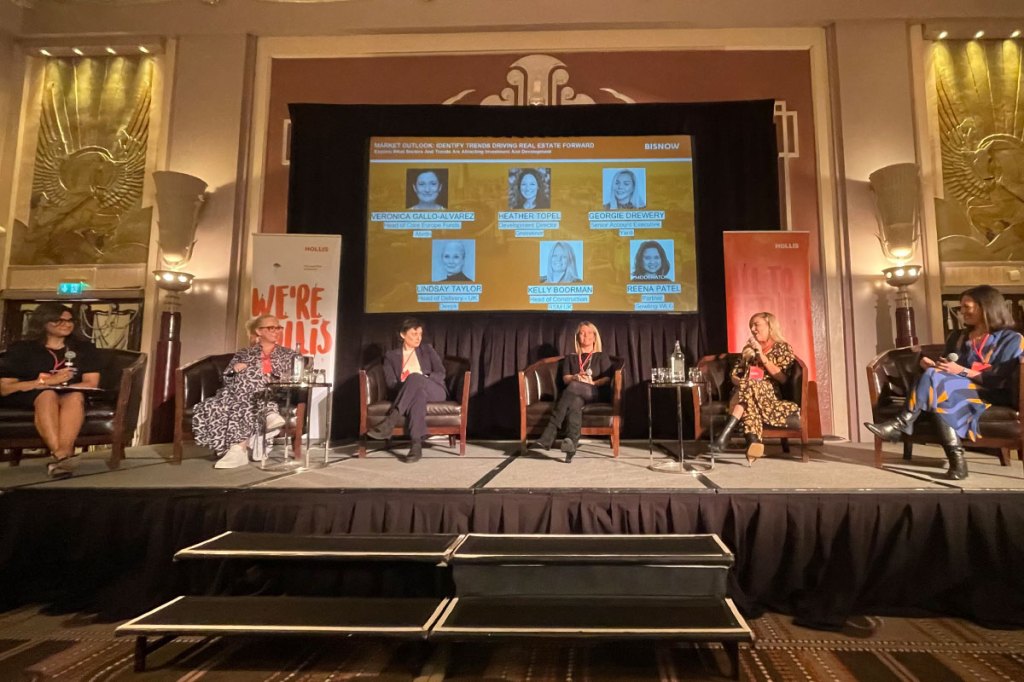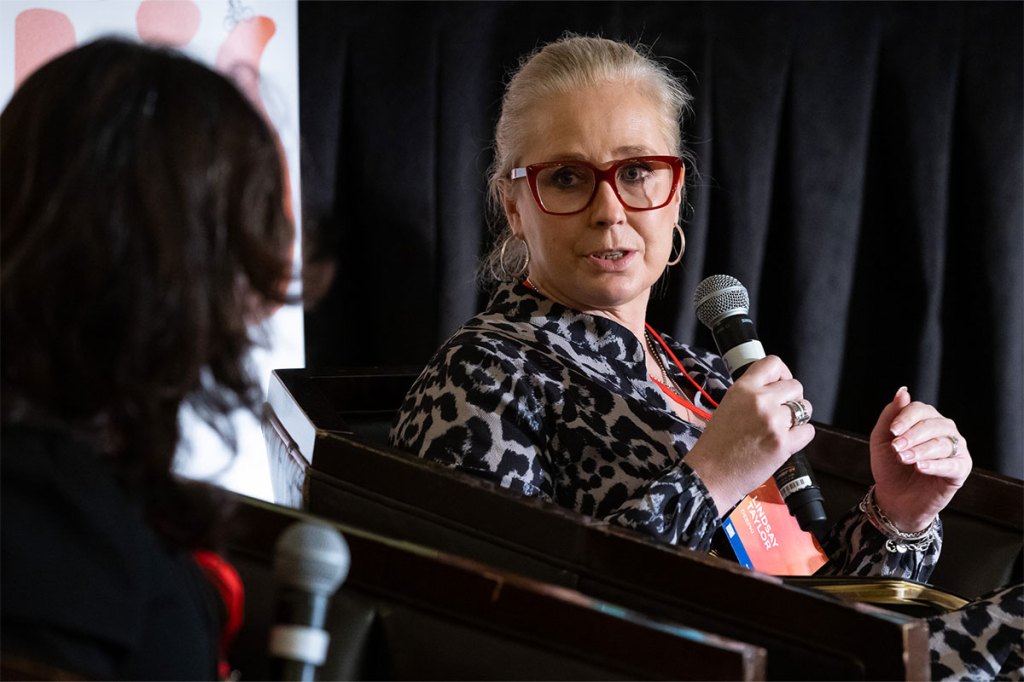At the 2023 Bisnow Women Leading Real Estate Conference, Yardi’s Georgie Drewery, senior account executive, joined industry experts to discuss the trends defining the future of real estate. The panel was moderated by Reena Patel, partner at Gowling WLG and included:
- Veronica Gallo-Alverez, head of core Europe funds for Abrdn
- Heather Topel, development director for Grosvenor
- Lindsay Taylor, head of delivery for UK Deepki
- Kelly Boorman, head of construction for RSM UK

Emphasis on Better Living and Working Standards
The COVID-19 pandemic has reshaped our understanding of living and working spaces. With remote work becoming the new normal, the demand for quality living spaces has surged.
Starting the discussion, Gallo-Alverez emphasises this notion and highlights how “there’s been a structural change in the way we live, in the way we work, we buy.” Renters are now seeking properties that offer more than just shelter. They want environments conducive to work, relaxation and well-being. A place where they “can eat, drink, shop and do all of the basic daily admin,” includes Topel, who further stresses that “you cannot operate in the future without driving environmental performance.” As a result, residential developers are focusing on creating multifunctional living spaces that incorporate communal areas, leisure centres and workstations.
On the commercial front, Gallo-Alverez spotlights the trend of returning to physical offices across Europe. She notes that unlike the UK, where remote work has gained substantial traction, countries like Germany and France will see a greater “push on staff coming back to their offices full time in the next three years.” However, Gallo-Alverez stresses that “companies will have to attract people and motivate people to come back to the office.” To achieve this, developers must provide state-of-the-art facilities with advanced connectivity that establishes a collaborative work environment. Thus, similarly to the residential sector, businesses in the commercial world realise that if they wish to attract future customers and retain current clients, they will have to improve their offerings and deliver “top-tier amenities as well as provide cutting-edge technology.”
Building for a Flexible Future
Consequently, the post-COVID work environment has reformed how we work and more significantly reshaped the demand for office spaces. With that thought in mind, Patel asked the panel, “How do developers/providers combat and accommodate this shift?” The answer is by “allowing landlords to have a more flexible contract,” states Drewery.

Traditional “25-to-30-year leases,” are giving way to more flexible arrangements. Shared office spaces are gaining popularity, “allowing businesses to pay for the specific resources and space they use.” This model benefits both landlords, “who can optimise space utilisation and revenue,” while allowing tenants to have the “flexibility to adapt their workspace needs,” shares Drewery.
But it all “comes back to amenities and making an enjoyable place to work,” adds Topel. She highlights that “everything that we want as individuals, we should expect our customers, our clients, are looking for as well. So again, amenities in buildings, whether that’s adjourning facilities…through to gyms immediately adjacent to the building.” To combat this shift, developers need to look at how they can foster a sense of community and connectivity within the building as much as providing “more flexible leasing opportunities.”
ESG Dominates the Agenda
Inevitably, the focus of the discussion then turned to the topic of ESG (Environmental, Social and Governance). The principles of ESG have taken centre stage in real estate investment decisions. More specifically, the “E and S” aspects, states Gallo-Alverez, which will gain more prominence in the future. She notes that both tenant preferences and investor demand drive this shift. Tenants, especially “younger generations, are increasingly conscious of the environmental footprint of their living and working spaces.” They seek buildings and developments that prioritise energy efficiency, green practices and social well-being.

In tandem with tenant preferences, investors will place greater importance on ESG considerations when evaluating real estate portfolios. “Why? Because the generation today is very focused on sustainability,” as previously shared by Gallo-Alverez.
Taylor further notes that “investors are saying any asset which has a strong ESG portfolio will exhibit low risks and high incentives, especially through the next few years.” The emphasis on sustainability and social impact aligns with broader societal goals and reflects a commitment to responsible investing. This transition has led to a revaluation of traditional real estate portfolios. Themes such as sustainability, eco-friendly design and community well-being are now central to investment strategies – “driving the development of trend-focused portfolios,” quotes Gallo-Alverez.
The Technological Revolution in Construction
In addition, technology was another important topic that the panel and the moderator couldn’t avoid exploring. It is revolutionising and will continue to revolutionise the construction industry, as Boorman points out, “reshaping how buildings are designed, constructed and operated.” However, she notes that to achieve more efficient buildings in the future, the “integration of data-driven decision-making will become fundamental,” to creating more effective, transparent and sustainable buildings. Therefore, to attain these goals “advanced technologies, including artificial intelligence (AI),” must be employed by real estate developers. To help “streamline construction processes, enhance energy efficiency and optimise building performance,” states Boorman.
Taylor expands on this topic and highlights how data analytics and IoT (Internet of Things) devices are providing valuable insights into “user behaviour and building performance.” She agrees with Boorman’s notion that this data-driven approach will allow developers to make informed decisions about “design, materials and operational strategies.” Taylor stresses that by leveraging technology, the construction industry will be positioned to construct buildings that not only meet immediate needs but also maintain “long-term sustainable and environmental benefits.”
Honourable Mention: The Rise of Blended Living
Lastly, Drewery notes the trend of ’blended living’, which is increasing its momentum across Europe and is further gaining interest in the UK.
Unlike traditional housing models that segregate demographics, blended living promotes inclusive, diverse communities within residential spaces. This “concept is particularly advanced in Europe,” where it seeks to bridge the gap between students and young professionals. It is a trend, that Drewery notes is “gradually making its way into the UK real estate market.”
BTR (Build to Rent) developers and landlords are recognising the potential of blended living, as “it attracts a diverse tenant base” and fosters a sense of community within their properties. It offers flexible leasing options and shared amenities that positively promote collaboration and interaction – an innovative living model “which is trying to integrate to the UK real estate market,” states Drewery.





See what events we’ll be attending in 2023 and meet with Team Yardi or get in touch to see how our end-to-end property management technology can help drive your real estate operations forward.